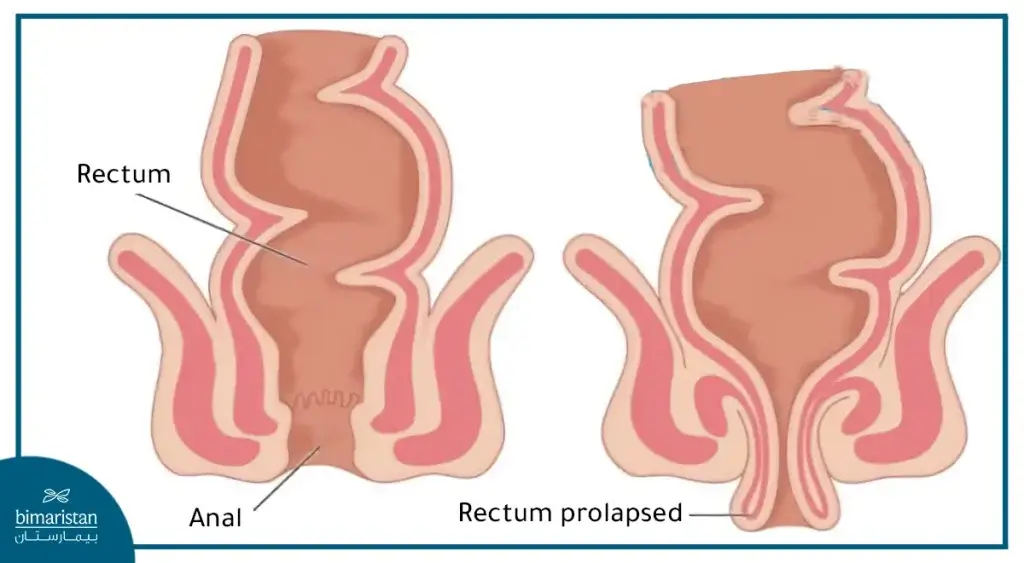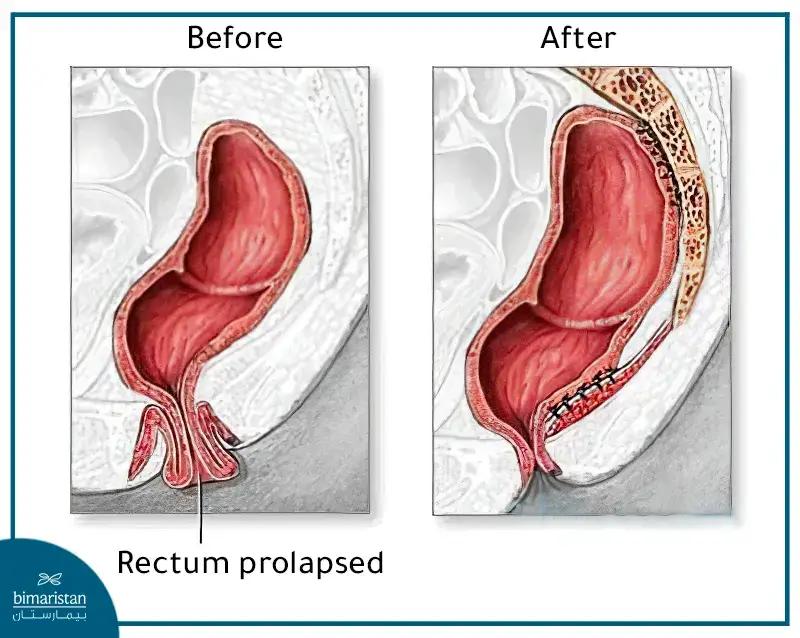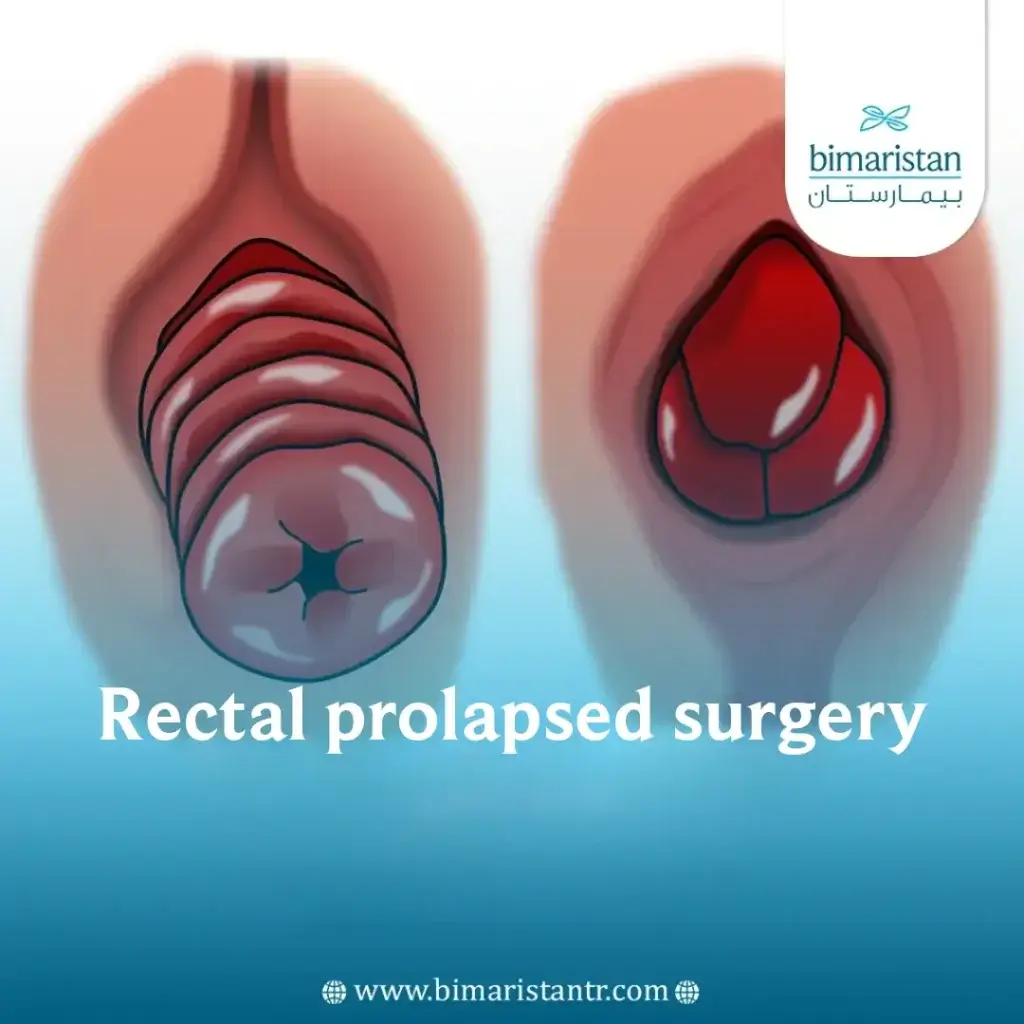Rectal prolapse through the anus causes disturbing symptoms that require treatment. Rectal prolapse surgery can be performed with minimally invasive surgical techniques in Turkey.
What is rectal prolapse?
Rectal prolapse is known as the prolapse of the rectum outside its normal place downward. The patient may notice his prolapsed rectum during defecation or when standing in the form of a red mass protruding from the anus.
The rectum separates the last parts of the colon from the anus and forms a temporary storehouse for waste until it is excreted outside the body. A normal person’s rectum cannot be seen with the eye, but in cases of prolapse, it may be easily seen as a prolapsed red mass that somewhat resembles hemorrhoids.
Rectal prolapse is a common condition in elderly people who suffer from chronic constipation. It occurs more frequently in postmenopausal women and may also affect young children.
The rectum is often returned to its natural place through surgery, and currently, in Turkey, surgery is performed using advanced minimally invasive techniques that are low-risk.

Difference between rectal prolapse and hemorrhoids
Comparison table between rectal prolapse and hemorrhoids
| Hemorrhoids | Rectal prolapse | |
| Swollen veins in the anus and lower rectum | Part of the rectum slips out of the anus | Definition |
| Increased pressure on the veins due to constipation, pregnancy, sitting for long periods, and lifting heavy weights | Weakness of supporting muscles, chronic constipation, previous surgery | Reasons |
| Pain, itching, bleeding during a bowel movement, swelling or lumps around the anus | Protrusion of the rectum from the anus, pain, bleeding, difficulty controlling bowel movements | Symptoms |
| Changing lifestyle, using ointments and suppositories, and in severe cases, performing simple surgery to remove hemorrhoids | Surgical intervention to restore the rectum and strengthen the supporting muscles | Treatment |
Rectal prolapse symptoms
The most common symptom of rectal prolapse is noticing the prolapsed rectum as a red mass protruding from the anus. This mass is particularly noticeable during defecation, and as the condition develops, it becomes visible when standing and walking.
Other symptoms of rectal prolapse include:
- Bloody stool and pain during defecation
- Fecal incontinence (loss of control over defecation)
- Feeling like defecating even though there is no stool
- Constipation or diarrhea
- Excretion of mucus or pus in the stool
These were the most common symptoms of rectal prolapse.
Read about Colorectal surgery
Causes for rectal prolapse
The main cause is still not clearly understood. Some doctors believe that rectal prolapse is caused by weakness of the muscles that keep the rectum in place, while others believe that it occurs in women after childbirth.
Scientists agree that there are several factors that predispose to rectal prolapse, which are:
- Chronic constipation or diarrhea
- Nerve injury to the nerves responsible for contracting the muscles of the rectum and anus
- Constant severe clenching during defecation
- Previous traumatic injury to the pelvic area around the rectum
- Infections at the anal and rectal level
- Some diseases, such as cystic fibrosis or diabetes
- It may be associated with uterine or vaginal prolapse
Read about: Hemorrhoids treatment in Turkey
Diagnosing rectal prolapse
The doctor takes a detailed clinical history of the patient and knows his medical history. The presence of chronic constipation may increase suspicion of the possibility of rectal prolapse.
A distinction must be made between rectal prolapse and hemorrhoids, as they are two different medical conditions. The doctor may use one of the following tests to confirm the diagnosis and rule out other causes:
Rectal examination (anal palpation): The doctor wears a glove and inserts his finger through the anus into the rectum. He assesses the strength of the anal sphincter and looks for masses, abnormalities, or bleeding.
Anal pressure measurement: It is done by inserting a narrow, flexible tube containing a balloon at the bottom into the rectum. The balloon is inflated, and the force of contraction of the anal sphincter is measured.
Anal electromyography: This test is useful in determining whether the cause of rectal prolapse is a defect in the innervation of the anal sphincter muscle.
Colonoscopy: It is used to rule out other causes, such as the presence of polyps or tumors in the large intestine, where a flexible tube containing a camera is inserted through the anus to view the large intestine.
Read more about colonoscopy.
Defecation radiography: This test is based on recording an x-ray video of the rectum and anus during the defecation process to study the presence of functional problems during defecation in the rectum.
Read about: Treatment of chronic anal fissure
Rectal prolapse surgery in Turkey
Surgery is often used to treat rectal prolapse in adults. The operation aims to return the rectum to its natural position and uses surgical techniques to repair or strengthen the rectal septum.
There are two methods for rectal prolapse surgery:
Transabdominal intervention
Through this method, surgical incisions are made in the abdomen to fix the rectum in its natural place. If there is a long history of constipation, the surgeon may remove part of the colon and then restore the rectum.
Transabdominal intervention is performed in healthy patients without diseases that would hamper the surgical procedure.
Transperineal intervention
This method is used in older patients who suffer from health problems that make abdominal surgery difficult to perform. There are two methods of surgical technique available:
Altemeier procedure: In this procedure, the descending part of the rectum is excised, and then the two ends are sutured together.
Delorme procedure: Only the inner lining of the descending rectum is removed, and then the two ends of the inner lining are sutured together. After that, the outer layer of the descending rectum is folded and returned to its normal place.
Minimally invasive rectal prolapse surgery in Turkey
Surgical methods used in modern medicine have evolved as modern technology has recently emerged, which is low-risk and easy to implement, such as using robots in surgical operations.
Turkey has worked to provide the latest treatment methods to correct rectal prolapse, including:
Laparoscopic rectal prolapse surgery
After anesthetizing the patient, the surgeon makes a small surgical incision in the abdomen and then inserts the laparoscope (a tubular device with a camera underneath).
The doctor locates the sigmoid colon and rectum, frees it from the surrounding tissue, and returns the descending rectum to its natural place.
Read about: Treating ulcerative colitis

Robotic rectal prolapse operation
Using an automated device controlled by the surgeon, the operation can be performed with extreme precision, clear three-dimensional vision, and the least possible risk. After making very small surgical incisions, the rectum is fixed to its natural place with extreme precision using a robot.
Read about: Infertility treatment for men
Advantages of minimally invasive rectal prolapse surgery
Minimally invasive rectal prolapse repair has the following advantages over traditional open surgery:
- The risk of complications such as sepsis is less likely to occur
- The amount of blood lost is much less than with open surgery
- Fast recovery after the operation, as the patient returns to his normal life within a short period
- Its results are often better than open surgery
- Surgical scars are less
- The pain will be less
After surgery
The period of stay in the hospital after the operation depends on the type of surgery performed. In traditional open rectal operations, the patient stays in the hospital for about 5 to 8 days, and this period is shorter when less invasive methods are used, such as laparoscopy.
You should drink plenty of fluids after the operation, and the doctor may prescribe stool softeners during the recovery period along with a diet rich in fiber in the weeks following surgery to avoid constipation, which may lead to rectal prolapse again.
Most patients return to their normal lives within 4 to 6 weeks postoperatively, and symptoms often resolve completely in most patients.
Rectal prolapse treatment without surgery
As we mentioned previously, surgery is the main method of treating rectal prolapse, but other methods, such as herbs and physical therapy, can help treat it in its initial mild stages.
Treating rectal prolapse with herbs
Rectal prolapse patients are advised to eat a lot of fiber-rich foods, especially fruits and vegetables, to avoid constipation, which negatively affects prolapse. Ellipse herbs, raisins, black seed, chamomile, and ginger are among the herbs that can manage constipation and treat rectal prolapse.
The effectiveness of herbs in treating rectal prolapse has not yet been clearly proven, and studies are still ongoing on this type of treatment.
Treatment of rectal prolapse with exercise
Some exercises are useful in strengthening the pelvic floor muscles, as these muscles support the uterus, bladder, and rectum and increase constipation to prevent the organs from prolapsing downward. The most important of these exercises are:
Kegel exercises
Sit or stand in a comfortable position with your legs apart, then identify the target muscles well and pull the muscle as if you were trying to prevent the passage of gas from the intestines.
Imagine yourself as if you are about to urinate and then tense the muscles you use to suddenly stop urinating and pull the pelvic muscles from back to front as much as possible.
Hold the tension for about ten seconds, then relax the muscles. Rest for about five seconds, and then repeat this exercise several times in a row.
Manual rectal elevation exercises
Wash your hands well and wear gloves. Then, insert your finger into the descending rectum, apply pressure on it, and gently pull it upward. Repeat this process several times in a row.
Stop performing these exercises if you feel pain. In all cases, consulting a specialist doctor is the best option. The specialist will teach you how to perform these exercises at home if you need them.
Read about: Treatment of irritable bowel syndrome in women in Turkey
Can you live with rectal prolapse?
It depends on the patient’s condition and severity. Rectal prolapse may be treated with lifestyle changes, diet modification, and pelvic muscle-strengthening exercises. In some severe cases, surgical treatment may be necessary.
Rectal stapling procedure price
The price varies from one country to another and from one case to another, depending on the country in which you are being treated or the hospital, as there will be different prices. Therefore, it is best to consult your doctor or a specific medical institution to get an accurate estimate of the cost of rectal stapling in the country or region where you live.
Read more articles:
Guide to General Surgery in Turkey
Stool transportation process in Turkey
Organ Transplantation in Turkey
Sources:

